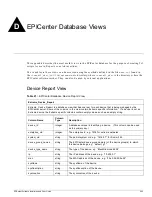
The ImportResources Utility
EPICenter Software Installation and User Guide
491
Importing from an LDAP Directory.
Importing from an LDAP directory uses an import specification
file that defines the following:
•
The information you want to extract from the directory.
•
How to map that data to groups, resources, and attributes in the EPICenter Grouping module.
The specification file must be named
LDAPConfig.txt
, and must reside in the EPICenter
user/import
directory. See “Importing from an LDAP Directory” in Chapter 8 for details.
Importing from an NT Domain Controller or NIS Server.
Importing from an NT Domain Controller
or NIS server is always done from the Domain Controller or NIS server that is serving the domain for
the system running the EPICenter server. The type of system you are running will determine where the
EPICenter server looks for the information. See “Importing from an NT Domain Controller or NIS
Server” in Chapter 8 for details.
The syntax of the ImportResources command is as follows:
ImportResources -user
<
EPICenter username
>
-s
<
source name
>
[
-f
<
file name
>|
-ldap
|
-domain
]
The EPICenter user name and one of the import type options (
-f
,
-ldap
, or
-domain
) are required.
Table 20 specifies the options you can use with this command:
Table 20: ImportResources command options
Option
Value
Default
-user <username>
EPICenter user name. This option is required.
None
-password <password>
EPICenter user password. If the password is blank, do not
include this argument.
No password
-host <hostname | IP address>
EPICenter server hostname or IP address
localhost
-port <port>
EPICenter server port number
80
-help
Displays syntax for this command
None
-s <Source name>
A name that will identify the source of the imported
resources. This name is used to create a group under
which all the resources imported in this operation are
placed.
None
-f <file name>
The name of a tab-delimited text file that contains the data
to be imported. See “Importing from a File” in Chapter 8 for
details.
None
-ldap
Specifies that the information to be imported is from an
LDAP directory. Requires a specification file named
LDAPConfig.txt, that resides in the EPICenter user/import
directory. See “Importing from an LDAP Directory” in
Chapter 8 for details.
None
-domain
Specifies that the information to be imported is from an NT
Domain Controller server or a Solaris NIS server. See
“Importing from an NT Domain Controller or NIS Server” in
Chapter 8 for details.
None
Summary of Contents for EPICenter 4.1
Page 20: ...20 EPICenter Software Installation and User Guide Preface ...
Page 46: ...46 EPICenter Software Installation and User Guide EPICenter and Policy Manager Overview ...
Page 190: ...190 EPICenter Software Installation and User Guide Configuration Manager ...
Page 204: ...204 EPICenter Software Installation and User Guide Using the Interactive Telnet Application ...
Page 242: ...242 EPICenter Software Installation and User Guide Using the IP MAC Address Finder ...
Page 266: ...266 EPICenter Software Installation and User Guide Using ExtremeView ...
Page 284: ...284 EPICenter Software Installation and User Guide Real Time Statistics ...
Page 436: ...436 EPICenter Software Installation and User Guide Using the Policy Manager ...
Page 454: ...454 EPICenter Software Installation and User Guide The ACL Viewer ...
Page 468: ...468 EPICenter Software Installation and User Guide Troubleshooting ...
Page 504: ...504 EPICenter Software Installation and User Guide EPICenter External Access Protocol ...
Page 510: ...510 EPICenter Software Installation and User Guide EPICenter Database Views ...
Page 522: ...522 EPICenter Software Installation and User Guide EPICenter Backup ...
Page 526: ...526 EPICenter Software Installation and User Guide Dynamic Link Context System DLCS ...
Page 546: ......






























